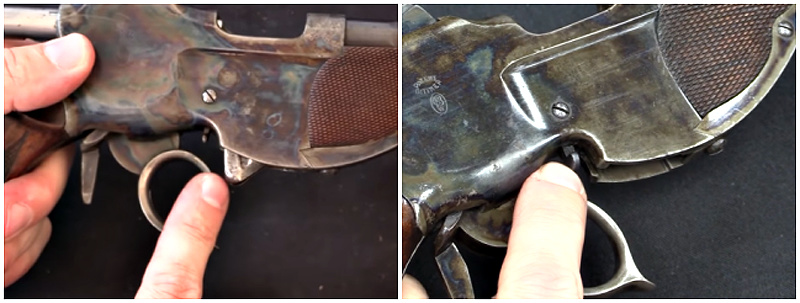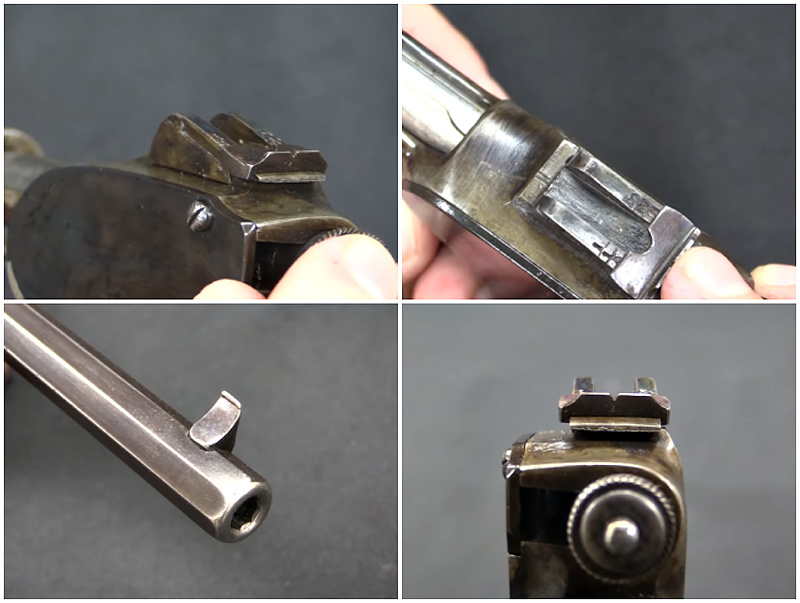I’m too old to have been caught up in the Steampunk thing. I don’t know whether it’s a fad, a game, a trend, a hobby, a cosplay thing…maybe all of those? Whatever. But some of that stuff is, admittedly, pretty sweet looking. And I like how some of it is based on actual historical devices, even if they have been tricked out. Hey, if an upgraded Mauser Broom Handle is good enough for Han Solo…
Anyhow, some historical artifacts don’t need enhancement. That’s ‘cause they already have the cool built in. One of those artifacts is the Bittner Ring Pistol, brought to us by everyone’s favorite historical gun aficionado, Ian McCollum of Forgotten Weapons.

I have to say, when I first looked at the Bittner, I wasn’t so sure of the coolness angle. It’s kinda odd looking. But, as I watched Ian’s video taking me through the history and function of the gun, I changed my tune. The operating system is simple, yet very clever and it looks like it would be reliable. The craftsmanship looks to be first-rate. So, I’ll give you the rundown, then you can go over and check it out yourself. Or vice-versa. There are actually two videos, one on the gun and one on the clip, which Ian acquired later.
A Little Bittner History
The Bittner is designated either “1893” or “1896.” Depending, as Ian tells us, on what source you use. Bohemian gunsmith Gustav Bittner designed and patented the gun in 1893. The first pistols were produced in 1896. The examples we have that were processed through the Vienna Proof House are dated 1897 and 1898. Whichever works for you. I doubt that Gustav cares much at this point. They were proofed in Vienna because Bohemia was part of the Austro- Hungarian Empire at the time and Vienna was the Imperial capital. There’s your history lesson for the day. That will likely be on the test.

The 1880s and 1890s saw several designs featuring the manually operated ring “trigger.” The ring really isn’t the trigger, but we’ll get to that. The Bittner was one of the last of that trend and was easily the most successful and most common today. Keep in mind the word “common” is relative, in this instance, to the other ring trigger designs of the time. Maybe a better term would be “less rare,” since a maximum of four to five hundred Bittners were produced. That number is still way more than any of the others. As a result, if you want a Bittner for your cosplay outfit, you better break out the credit card and have a high spending limit.
Bittner Craftsmanship and Clever Mechanics
The firing system is a simplified version of the 1887 Passler and Siedl design, making the pistol easier to manufacture and likely more reliable. All the metal is case hardened steel, except for the octagonal barrel. The case hardening gives it a unique coloring that grew on me the more I looked at it. Each pistol would have an individual look, despite being made to the same specifications. The dark wood of the grips and side panels is finely checkered, giving a very real appearance of quality. The wood side panels cover the integral magazine follower and spring.

The magazine in the frame is fed by a five-round clip, which is pushed down from the top onto the follower. There is a clip release lever on the underside of the frame between the ring and the magazine, similar to that of the Mannlicher straight-pull rifles of the time. The clip is also made in the Mannlicher style. It is removed from the top, though, when loaded, part of it protrudes from the bottom of the frame past the follower.


Simple Operation
The gun is chambered in 7.7mm Bittner, a black powder cartridge derived from the .320 Short Revolver. Good luck finding that one. The gun is manually operated using the ring, operated by the trigger finger, to open and close the bolt, thereby chambering a round and cocking the pistol. When the ring comes back as part of the cocking operation, the trigger finger rests on the actual trigger, which is then depressed to release the striker and fire the gun. Yes, it’s striker-fired. There are two techniques for operating the ring, one simulating single action and the other double action. It’s really very simple either way. You can watch the video to see Ian demonstrate. The sights are functional, with a prominent blade front sight and a rear notch. The rear sight can be adjusted for distance at 50, 100, and 150 meters.


Improved Internals
Disassembly requires a screwdriver to take off the access plate on the left side of the frame. Once that is done, it’s a simple matter to remove the ring mechanism to get to the bolt and trigger. Earlier ring designs had used the bottom access screw as the trigger axis, causing the whole thing to come apart when the plate was removed. They also had to be held all together to replace it. A real pain. Bittner fixed that problem by machining the trigger axis into the frame and having the access screw go right into it. That way, you can take it apart and put it back together easily without stuff springing everywhere.

The machining is simple, but evolved from earlier designs, leading to easier maintenance and reliability. The bolt is easily removed. When Ian does that, he points out the large locking lug and where it locks to the frame when the gun is cocked. Looks very solid. When Ian takes it apart and explains it, the Bittner is really a pretty slick system.


Final Thoughts
Ian says that if he were to have a gun that he would be “very happy to just hang on the wall as a piece of art, in addition to being a functional firearm,” the Bittner would be it. “The combination of the dark wood and the checkering and the case hardening on all the main components is just absolutely beautiful.”
“I think the styling of it is this fantastic, sort of Victorian Steampunk design. They’re fantastic. I’d love to have one myself at some point.” I really can’t add anything to that, so I
won’t, other than to say, “Amen!”


